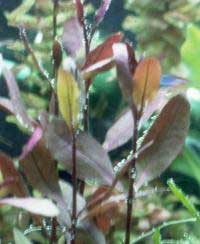home aquariums
ENCYCLOPEDIA OF PLANTS
Alternanthera sessilis (Alternantera sedentary)

Family Amaranthaceae (Amaranth)
Spread. There are in all warm countries.
Annual or perennial amphibious plant with erect or creeping stems. 3 - 10 mm, from round to faceted in diameter, stem more or less ramified and roots with creeping shoots him grow on all nodes. Leaves are opposite with a cruciform arrangement have petiole 0.5 - 1.5 cm in length, shape and size are very diverse. Leaf blade from the linear-lanceolate to elongated, pointed to and based on the rounded end. It can reach sizes of up to 6 - 9 (15) X 1.5 (3) See entire leaves.. Only leaf axis and on two opposite sides of the stem narrow strips of bare plant. Venation melkorazvetvlёnnoe a clearly marked central vein. The stem and the front side of the sheet from wine-red to dark red or greenish-red color, the back side of rich purple.
Flea, terminal or axillary inflorescences - cropped, egg-shaped spikes 5 mm in length, consisting of numerous tightly pressed against each other individual flowers. They are surrounded by two bracts about 0.5 cm long. Each individual flower five white at the base of poorly dyed reddish-purple sepals with a veined, pointed, 3,5 mm long and 2 mm wide base. The number of stamens from 2 to 5. The fruit in the form of an inverted heart, size 2, 0 x 1,5 mm.
From time to time a commercially available, but is not suitable for continuous culture in the aquarium. However, this plant is a decent and growing species for palyudariumov. Wine-red color of its leaves creates a wonderful contrast with green views. In paludarium ground as possible should be dry. The temperature can range from 15 to 30 degrees C. Although the deficit of light shoots grow more healthy, but the interstices have lengthened, that does not look too good. With sufficient illumination formed dense, decorative shoots. Alternanthera sessilis easily propagated by lateral shoots or seeds.
Alternantera sedentary can occur in a variety of places, such as in rice fields and in wet ditches, along the banks of a small pond, as well as completely dry areas. Mostly it grows in the plains, but occurs at higher elevations up to 1200 m. Often grows as a weed in ditches.


Comments
Commenting, keep in mind that the content and the tone of your messages can hurt the feelings of real people, show respect and tolerance to his interlocutors, even if you do not share their opinion, your behavior in terms of freedom of speech and anonymity offered by the Internet, is changing not only virtual, but real world. All comments are hidden from the index, spam control.